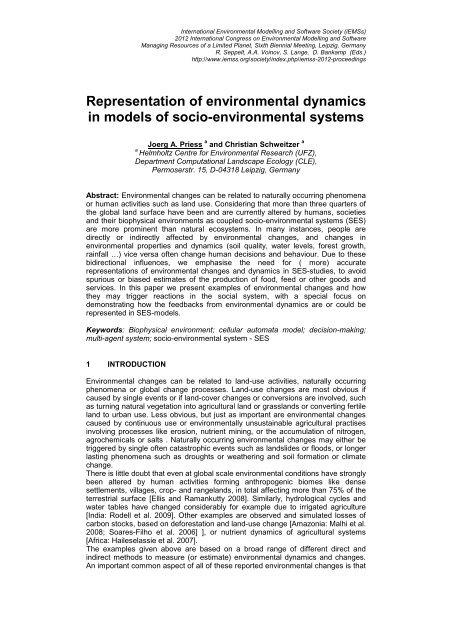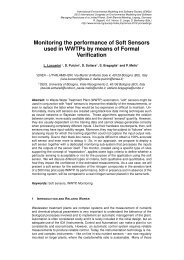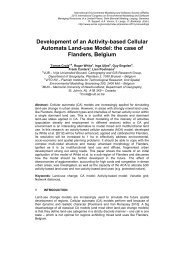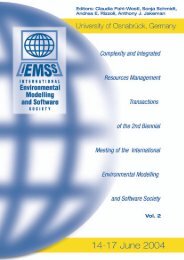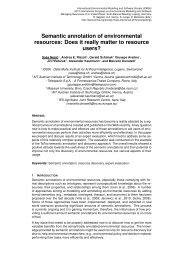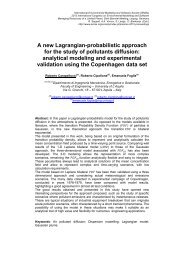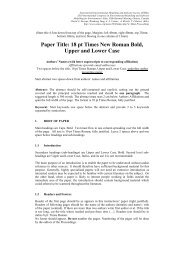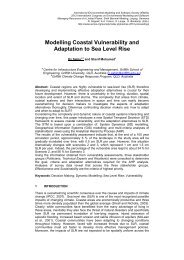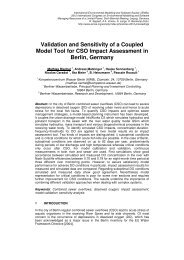Paper details - International Environmental Modelling and Software ...
Paper details - International Environmental Modelling and Software ...
Paper details - International Environmental Modelling and Software ...
Create successful ePaper yourself
Turn your PDF publications into a flip-book with our unique Google optimized e-Paper software.
<strong>International</strong> <strong>Environmental</strong> <strong>Modelling</strong> <strong>and</strong> <strong>Software</strong> Society (iEMSs)<br />
2012 <strong>International</strong> Congress on <strong>Environmental</strong> <strong>Modelling</strong> <strong>and</strong> <strong>Software</strong><br />
Managing Resources of a Limited Planet, Sixth Biennial Meeting, Leipzig, Germany<br />
R. Seppelt, A.A. Voinov, S. Lange, D. Bankamp (Eds.)<br />
http://www.iemss.org/society/index.php/iemss-2012-proceedings<br />
Representation of environmental dynamics<br />
in models of socio-environmental systems<br />
Joerg A. Priess a <strong>and</strong> Christian Schweitzer a<br />
a<br />
Helmholtz Centre for <strong>Environmental</strong> Research (UFZ),<br />
Department Computational L<strong>and</strong>scape Ecology (CLE),<br />
Permoserstr. 15, D-04318 Leipzig, Germany<br />
Abstract: <strong>Environmental</strong> changes can be related to naturally occurring phenomena<br />
or human activities such as l<strong>and</strong> use. Considering that more than three quarters of<br />
the global l<strong>and</strong> surface have been <strong>and</strong> are currently altered by humans, societies<br />
<strong>and</strong> their biophysical environments as coupled socio-environmental systems (SES)<br />
are more prominent than natural ecosystems. In many instances, people are<br />
directly or indirectly affected by environmental changes, <strong>and</strong> changes in<br />
environmental properties <strong>and</strong> dynamics (soil quality, water levels, forest growth,<br />
rainfall …) vice versa often change human decisions <strong>and</strong> behaviour. Due to these<br />
bidirectional influences, we emphasise the need for ( more) accurate<br />
representations of environmental changes <strong>and</strong> dynamics in SES-studies, to avoid<br />
spurious or biased estimates of the production of food, feed or other goods <strong>and</strong><br />
services. In this paper we present examples of environmental changes <strong>and</strong> how<br />
they may trigger reactions in the social system, with a special focus on<br />
demonstrating how the feedbacks from environmental dynamics are or could be<br />
represented in SES-models.<br />
Keywords: Biophysical environment; cellular automata model; decision-making;<br />
multi-agent system; socio-environmental system - SES<br />
1 INTRODUCTION<br />
<strong>Environmental</strong> changes can be related to l<strong>and</strong>-use activities, naturally occurring<br />
phenomena or global change processes. L<strong>and</strong>-use changes are most obvious if<br />
caused by single events or if l<strong>and</strong>-cover changes or conversions are involved, such<br />
as turning natural vegetation into agricultural l<strong>and</strong> or grassl<strong>and</strong>s or converting fertile<br />
l<strong>and</strong> to urban use. Less obvious, but just as important are environmental changes<br />
caused by continuous use or environmentally unsustainable agricultural practises<br />
involving processes like erosion, nutrient mining, or the accumulation of nitrogen,<br />
agrochemicals or salts . Naturally occurring environmental changes may either be<br />
triggered by single often catastrophic events such as l<strong>and</strong>slides or floods, or longer<br />
lasting phenomena such as droughts or weathering <strong>and</strong> soil formation or climate<br />
change.<br />
There is little doubt that even at global scale environmental conditions have strongly<br />
been altered by human activities forming anthropogenic biomes like dense<br />
settlements, villages, crop- <strong>and</strong> rangel<strong>and</strong>s, in total affecting more than 75% of the<br />
terrestrial surface [Ellis <strong>and</strong> Ramankutty 2008]. Similarly, hydrological cycles <strong>and</strong><br />
water tables have changed considerably for example due to irrigated agriculture<br />
[India: Rodell et al. 2009]. Other examples are observed <strong>and</strong> simulated losses of<br />
carbon stocks, based on deforestation <strong>and</strong> l<strong>and</strong>-use change [Amazonia: Malhi et al.<br />
2008; Soares-Filho et al. 2006] ], or nutrient dynamics of agricultural systems<br />
[Africa: Haileselassie et al. 2007].<br />
The examples given above are based on a broad range of different direct <strong>and</strong><br />
indirect methods to measure (or estimate) environmental dynamics <strong>and</strong> changes.<br />
An important common aspect of all of these reported environmental changes is that
Priess & Schweitzer / <strong>Environmental</strong> dynamics in SES<br />
they all sooner or later become relevant for decisions related to the use of the<br />
corresponding resources. Consequently, l<strong>and</strong>-management decisions or expected<br />
productivities of natural resources will result in spurious estimates if based on<br />
outdated or insufficiently specified environmental status or environmental dynamics.<br />
Thus the lack of biophysical information may negatively affect short-term individual<br />
goals such as production or profits, but also long-term societal goals such as the<br />
sustainable use of resources Given that knowledge about environmental dynamics<br />
<strong>and</strong> their impacts relevant for decision making, it is obvious that a time lag occurs<br />
between the generation of new knowledge <strong>and</strong> its implementation in simulation<br />
models.<br />
Considering societies <strong>and</strong> their biophysical environments as coupled socioenvironmental<br />
systems – SES [Redman et al. 2004], changes in environmental<br />
properties frequently affect biodiversity, the productivity of natural <strong>and</strong><br />
anthropogenic ecosystems <strong>and</strong> in turn often influencing or changing human<br />
decisions <strong>and</strong> behaviour. Due to the close feedbacks between environmental<br />
dynamics, decision making <strong>and</strong> wellbeing of human societies, we emphasise the<br />
need for a more accurate representations of environmental change processes in<br />
studies of socio-environmental systems. We do not aim at other levels of detail in<br />
SES-studies <strong>and</strong> -models, but emphasize the need for an improved representation<br />
of environmental change <strong>and</strong>/or dynamics to avoid spurious results assuming static<br />
or stable biophysical conditions, or erroneous assumptions about the dynamics of<br />
the biophysical environment.<br />
The main objective of this paper is to analyse how environmental dynamics could<br />
be represented in models of socio-environmental systems to improve the<br />
representation of decision-making. We present examples of environmental<br />
changes <strong>and</strong> how they may influence or trigger reactions in the social system,.<br />
2 REPRESENTATION OF ENVIRONMENTAL DYNAMICS IN SES<br />
From the fact that more than three quarters of the ice-free terrestrial surface are or<br />
have been transformed by humans [Ellis <strong>and</strong> Ramankutty 2008], it follows that the<br />
vast majority of terrestrial systems have to be considered as SES in which human<br />
societies interact with their biophysical environment (Figure 1). In these biophysical<br />
environments, societies have adapted to changing conditions for millennia, but also<br />
caused (accidental) environmental changes or damages from a human<br />
perspective. Often rationales are, among other factors, related to a<br />
misinterpretation of environmental indicators [Gunderson <strong>and</strong> Holling 2001].<br />
As depicted in Figure 1, information about environmental status <strong>and</strong> dynamics is<br />
required at different levels of decision-making, although environmental processes<br />
might sometimes lack corresponding units in the social system to manage them<br />
[Pelosi et al. 2010]. In the following sections we will explain how a representation of<br />
dynamically changing biophysical environments can be implemented in two<br />
different widely applied modelling approaches i.e. (i) “Multi-Agent-Systems” (MAS)<br />
<strong>and</strong> (ii) models based on “Cellular-Automata” (CA).
Priess & Schweitzer / <strong>Environmental</strong> dynamics in SES<br />
Figure 1. Representation of environmental status <strong>and</strong> -dynamics in SES.<br />
Links between the components of the biophysical environment <strong>and</strong> the social<br />
system are not shown. (adapted from GLP [2005] <strong>and</strong> Schaldach <strong>and</strong> Priess<br />
[2008])<br />
2.1 Real-world examples<br />
Higher (hierarchical) levels of decision-making in administration <strong>and</strong> planning not<br />
necessarily require more aggregated environmental information than the individual<br />
level. Flood prevention in river basin management, the quality of drinking water or<br />
compliance with regulations to receive environmental payments are examples for<br />
precise (<strong>and</strong> partly also timely) information needed at various administrative levels,<br />
whereas for the assessment of l<strong>and</strong> cover, crop yields or similar variables<br />
aggregated or mean values may be sufficient. Often threshold levels are defined,<br />
such as a certain water level, or water quality indicators, beyond which<br />
environmental changes trigger decisions in the social system. At the level of<br />
individual or household decisions, environmental information may not only be<br />
relevant as absolute values, but can also trigger adaptation for example crop or<br />
management choices as relative values in a regional context, or changes over time.<br />
Reactions/adaptations to environmental changes may vary widely depending on<br />
individual objectives or on information communicated via the media or extension<br />
services.<br />
Additionally, environmental thresholds such as low water levels may generate<br />
hierarchical responses in the social system such as a prohibition to irrigate crops.<br />
These real-world examples demonstrate that different strategies are needed in<br />
SES-models to transmit information of environmental status <strong>and</strong>/or changes to the<br />
algorithms simulating decision-making.<br />
2.2 Examples for representing environmental dynamics in SES-models<br />
The concepts presented in this section have been motivated by various simulation<br />
studies using either MAS or CA models [Berger et al. 2007; Hurkens et al. 2008; Le<br />
et al. 2010; Manson 2005; Parker et al. 2003; Priess et al. 2011; Walsh et al. 2008].<br />
Model-components simulating decision-making based on MAS or CA, are both<br />
capable to “perceive” environmental changes, however using quite distinct
Priess & Schweitzer / <strong>Environmental</strong> dynamics in SES<br />
concepts. In MAS (Figure 2 left) it is possible to define different types of agents <strong>and</strong><br />
their interactions, for example to simulate households (or people) acting in diverse<br />
ways to biophysical information, or representing different institutions or levels of<br />
decision-making. The geographical context <strong>and</strong> other biophysical information may<br />
be represented by other types of agents or by grid-cells (=pixels). CA-based models<br />
(Figure 2 right) usually use a “pixel for people” approach, which means a pixel or a<br />
group of pixels represent a location in a study region <strong>and</strong> simultaneously mimic<br />
decisions for example at the household or individual (farmer) level. Different levels<br />
of decision-making can be based on different sets of cell-groups, for example<br />
“responsive” to water levels or water availability to simulate river basin<br />
management.<br />
In MAS <strong>and</strong> CA models different strategies can be applied to represent or simulate<br />
environmental dynamics or changes. In case no feedbacks between the social<br />
system <strong>and</strong> the biophysical environment are relevant (or of interest), changing<br />
conditions such as weather or climate can simply be read from a database. In this<br />
example one or more levels of the social systems react or adapt to environmental<br />
changes, but the biophysical environment cannot not be influenced by activities of<br />
the social system. However, as argued above, human activities gave rise to <strong>and</strong> are<br />
still causing environmental changes, calling for more elaborate strategies in which<br />
social <strong>and</strong> environmental dynamics <strong>and</strong> changes are at least partly simulated<br />
endogenously causing mutual effects. In a very simple representation, the social<br />
system would perceive one environmental indicator for example water availability or<br />
a crop yield level, take a decision, act <strong>and</strong> subsequently change the environment by<br />
acting in a certain fashion. More complex approaches are receptive to more<br />
environmental signals, being communicated between, or being specific for different<br />
agents (MAS) or levels of decision-making (MAS & CA). In both modelling<br />
approaches it is possible to simulate adaptations to environmental changes, e.g. by<br />
“remembering <strong>and</strong> comparing” past <strong>and</strong> recent information, or by relating the “own”<br />
environmental situation – be it as agent or as pixel - to the status of other agents or<br />
cells following both cases, a certain strategy can be based on the own relative or<br />
fixed, but also to adapted threshold values.<br />
Figure 2. Units perceiving environmental information in MAS <strong>and</strong> CA models.<br />
MAS (left): different communicating agents at two levels of decision-making<br />
CA (right): single communicating pixels or clusters of pixels exchanging<br />
information simulating units of decision-making at different levels.
Priess & Schweitzer / <strong>Environmental</strong> dynamics in SES<br />
3 DISCUSSION<br />
The urgent need for an improved monitoring of environmental conditions, especially<br />
in regions of intensive l<strong>and</strong>-use activities, has been clearly addressed (e.g. GLP<br />
[2005]), aiming at exp<strong>and</strong>ing our knowledge of coupled SES [Liu et al. 2007;<br />
Redman et al. 2004], <strong>and</strong> to improve their representation in SES models. An<br />
excellent example for environmental monitoring is the publicly available satellitebased<br />
monitoring system of deforestation of the Amazon - the PRODES<br />
Programme, which is perhaps the most advanced deforestation surveillance<br />
scheme in the world (www.obt.inpe.br/prodes/index.html).<br />
In this paper we presented some of the links between environmental changes <strong>and</strong><br />
decision-making, mainly based on l<strong>and</strong>-use examples. By using two frequently<br />
applied simulation approaches, we have shown how environmental dynamics can<br />
be linked with decision-making in SES-models. We argue that even with simple<br />
representations of environmental dynamics/changes, for example with reduced or<br />
no interaction between agents or “decision-making” pixels, errors in terms of l<strong>and</strong><br />
dem<strong>and</strong>s, crop yields, management strategies or economic returns can be<br />
considerably reduced [Berger et al. 2007; Das et al. 2011; Le et al. 2010; Priess et<br />
al. 2011]. Addressing changing biophysical environments is especially important,<br />
when longer time periods are considered e.g. to explain historical l<strong>and</strong>-use<br />
dynamics or scenarios of potential future changes (e.g. climate change,<br />
intensification of l<strong>and</strong> use, etc.). The key to improve calculations/estimates is to<br />
make the information of changes in biophysical conditions available for the different<br />
levels of simulated decision making, which may involve the communication or<br />
processing of environmental information in the social sub-system. In modelling<br />
studies the latter would apply to any type of decision algorithm, irrespective of the<br />
methodology or mathematical approach used to represent the perception of <strong>and</strong> the<br />
reaction/adaptation to environmental changes. The above applies to (slowly)<br />
accumulating effects such as soil depletion, potentially not causing any reaction for<br />
several years, but also to conditions triggering an immediate response, if for<br />
example water availability falls below a threshold needed to provide irrigation water<br />
or cooling water for industrial or energy production.<br />
It has also been argued [Feld et al. 2009; Seppelt et al. 2011] that information about<br />
environmental conditions <strong>and</strong> dynamics is essential for the assessment of<br />
biodiversity, the provision of ecosystem goods <strong>and</strong> services <strong>and</strong> the benefits<br />
derived for human wellbeing [Potschin <strong>and</strong> Haynes 2011; Harrison et al. 2010].<br />
Current simulation models of socio-environmental systems seem to focus on the<br />
representation of a relatively small number of environmental variables <strong>and</strong><br />
ecosystem services, which can be derived [Priess et al. 2010], confirming the<br />
dem<strong>and</strong> for a stronger emphasis on environmental data <strong>and</strong> models as tools to<br />
analyse them [GLP 2005], also as a prerequisite for more reliably deriving<br />
ecosystem services [Seppelt et al. 2011].<br />
4 REFERENCES<br />
Berger, T., Birner, R., Díaz, J., McCarthy, N., Wittmer, H.. Capturing the complexity<br />
of water uses <strong>and</strong> water users within a multi-agent framework. Water Resources<br />
Management, 21, 129–148, 2007.<br />
Das, S., Priess, J. A., Schweitzer, C. <strong>Modelling</strong> regional scale biofuel scenarios - a<br />
case study for India. GCB Bioenergy, , 4(2), 1-17, 2011.<br />
Ellis, E. C., Ramankutty, N. Putting people in the map: anthropogenic biomes of the<br />
world. Frontiers in Ecology <strong>and</strong> the Environment, 6(8), 439-447, 2008.<br />
Fargione, J., Hill, J., Tilman, D., Polasky, S., Hawthorne, P. L<strong>and</strong> clearing <strong>and</strong> the<br />
biofuel carbon debt. Science, 319(5867), 1235-8., 2008.<br />
Feld, C. K., Martins da Silva, P., Paulo Sousa, J., De Bello, F., Bugter, R., Gr<strong>and</strong>in,<br />
U., Hering, D., Lavorel, S., Mountford, O., Pardo, I., Pärtel, M., Römbke, J.,<br />
S<strong>and</strong>in, L., Bruce Jones, K., Harrison, P. Indicators of biodiversity <strong>and</strong><br />
ecosystem services: a synthesis across ecosystems <strong>and</strong> spatial scales. Oikos,<br />
118, 1862-1871, 2009.
Priess & Schweitzer / <strong>Environmental</strong> dynamics in SES<br />
Foley, J. A., Defries, R., Asner, G. P., Barford, C., Bonan, G., Carpenter, S. R.,<br />
Chapin, F. S., Coe, M. T., Daily, G. C., Gibbs, H. K., Helkowski, J. H., Holloway,<br />
T., Howard, E. A., Kucharik, C. J., Monfreda, C., Patz, J. A., Prentice, I. C.,<br />
Ramankutty, N., Snyder, P. K. Global consequences of l<strong>and</strong> use. Science, 309,<br />
570-574, 2005.<br />
GLP. Global L<strong>and</strong> Project Science Plan <strong>and</strong> Implementation Strategy. IGBP Report<br />
No. 53 / IHDP Report No. 19 (p. 64). Stockholm, 2005.<br />
Gunderson, L. H., Hollings, C. S. Panarchy: Underst<strong>and</strong>ing transformations in<br />
human <strong>and</strong> natural systems. Isl<strong>and</strong> Press, Washington, DC, 2001.<br />
Haileslassie, A., Priess, J. A., Veldkamp, E., Lesschen, J. Nutrient flows <strong>and</strong><br />
balances at the field <strong>and</strong> farm scale: Exploring effects of l<strong>and</strong>-use strategies <strong>and</strong><br />
access to resources. Agricultural Systems, 94(2), 459-470, 2007.<br />
Harrison, P. A., V<strong>and</strong>ewalle, M., Sykes, M. T., Berry, P. M., Bugter, R., de Bello, F.,<br />
Feld, C. K., Gr<strong>and</strong>in, U., Harrington, R., Haslett, J. R., Jongman, R. H. G., Luck,<br />
G. W., Martins da Silva, P., Moora, M., Settele, J., Sousa, J. P., Zobel, M.<br />
Identifying <strong>and</strong> prioritising services in European terrestrial <strong>and</strong> freshwater<br />
ecosystems. Biodiversity <strong>and</strong> Conservation, 19(10): 2791-2822, 2010.<br />
Hurkens, J., Hahn, B., van Delden, H. Using the GEONAMICA® software<br />
environment for integrated dynamic spatial modelling. iEMSs 2008: <strong>International</strong><br />
Congress on <strong>Environmental</strong> <strong>Modelling</strong> <strong>and</strong> <strong>Software</strong>. Sànchez-Marrè, M., Béjar,<br />
J., Comas, J., Rizzoli, A., Guariso(Eds.), 2008.<br />
Le, Q. B., Park, S. J., Vlek, P. L. G. L<strong>and</strong> use dynamic simulator (LUDAS): A multiagent<br />
system model for simulating spatio-temporal dynamics of coupled humanl<strong>and</strong>scape<br />
system. 2. Scenario-based applications for impact assessment of<br />
l<strong>and</strong>-use policies. Ecological Informatics, 5(3): 203 - 221., 2010.<br />
Liu, J., Dietz, T., Carpenter, S. R., Alberti, M., Folke, C., Moran, E., Pell, A. N.,<br />
Deadman, P., Kratz, T., Lubchenco, J., Ostrom, E., Ouyang, Z., Provencher, W.,<br />
Redman, C. L., Schneider, S. H. & Taylor, W. W. Complexity of coupled human<br />
<strong>and</strong> natural systems. Science, 317, 1513-1516, 2007.<br />
Manson, S. Agent-based modeling <strong>and</strong> genetic programming for modeling l<strong>and</strong><br />
change in the Southern Yucatán Peninsular Region of Mexico. Agriculture,<br />
Ecosystems & Environment, 111(1-4), 47-62, 2005..<br />
Parker, D., Manson, S., Janssen, M., Hoffmann, M., Deadman, P. Multi-agent<br />
systems for the simulation of l<strong>and</strong>-use <strong>and</strong> l<strong>and</strong>-cover change: a review. Ann.<br />
Assoc. Am. Geogr., 93, 314–337, 2003.<br />
Pelosi, C., Goulard, M., & Balent, G. The spatial scale mismatch between<br />
ecological processes <strong>and</strong> agricultural management: Do difficulties come from<br />
underlying theoretical frameworks? Agriculture, Ecosystems & Environment,<br />
139, 455-462, 2010.<br />
Potschin, M., Haines-Young, R. Ecosystem services: Exploring a geographical<br />
perspective. Progress in Physical Geography, 35(5): 575-594, 2011.<br />
Priess J. A., Schweitzer, C., Wimmer, F., Batkhishig, O., Mimler, M. The<br />
consequences of l<strong>and</strong>-use change <strong>and</strong> water dem<strong>and</strong>s in central Mongolia - an<br />
assessment based on regional l<strong>and</strong>-use policies. L<strong>and</strong> Use Policy, 28 (1): 4–10,<br />
2011.<br />
Priess, J. A., Schwarz, N., Lautenbach, S. Feedbacks in socio-environmental l<strong>and</strong><br />
systems. iEMSs 2010: <strong>International</strong> Congress on <strong>Environmental</strong> <strong>Modelling</strong> <strong>and</strong><br />
<strong>Software</strong>, Ottawa, Swayne, D. A., Wanhong Yang, Voinov, A. A.,Rizzoli, A.,<br />
Filatova, T. (Eds.), 2011.<br />
Redman, C. L., Grove, J. M., Kuby, L. H. Integrating Social Science into the Long-<br />
Term Ecological Research (LTER) Network: Social Dimensions of Ecological<br />
Change <strong>and</strong> Ecological Dimensions of Social Change. Ecosystems, 7(2), 161-<br />
171, 2004.<br />
Rodell, M., Velicogna, I., Famiglietti, J. S. Satellite-based estimates of groundwater<br />
depletion in India. Nature, 460 (7258), 999-1002, 2009.<br />
Schaldach, R., Priess, J. A. Integrated Models of the L<strong>and</strong> System : A Review of<br />
<strong>Modelling</strong> Approaches on the Regional to Global Scale. Living Rev. L<strong>and</strong>scape<br />
Res., 2(1), 1-34, 2008.<br />
Seppelt, R., Dormann, C. F., Eppink, F. V., Lautenbach, S., Schmidt, S. A<br />
quantitative review of ecosystem service studies: approaches, shortcomings <strong>and</strong><br />
the road ahead. Journal of Applied Ecology, 48(3), 630-636, 2011.
Priess & Schweitzer / <strong>Environmental</strong> dynamics in SES<br />
Soares-Filho, B. S., Nepstad, D. C., Curran, L. M., Cerqueira, G. C., Garcia, R. A.,<br />
Ramos, C. A., Voll, E., McDonald, A., Lefebvre, P., Schlesinger, P. <strong>Modelling</strong><br />
conservation in the Amazon basin. Nature, 440, 520-523, 2006.<br />
Walsh, S., Messina, J., Mena, C., Malanson, G., & Page, P. Complexity theory,<br />
spatial simulation models, <strong>and</strong> l<strong>and</strong> use dynamics in the Northern Ecuadorian<br />
Amazon. Geoforum, 39(2), 867-878, 2008.


